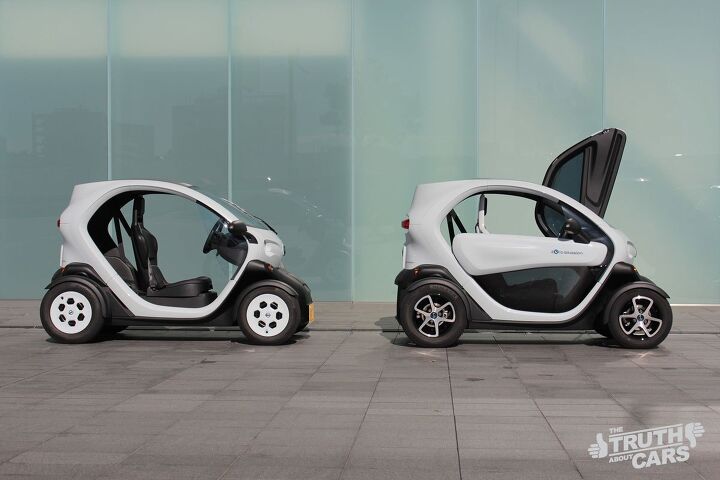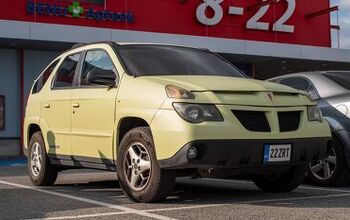Review: Nissan New Mobility Concept, JDM Spec

Today, I had a chance to do what I was never able to achieve in my meandering career in the automotive business: I could drive a concept car. In the past, I was able to drive pre-production models, mules, even prototypes (the latter very carefully, they are obscenely expensive to replace.) But I never drove a concept car. Concept cars usually are built to go on display at car shows, and “go” can be taken literally: Many don’t even have an engine. The concept car I will be driving is Nissan’s “New Mobility Concept”, something Nissan calls an “ultracompact” car.
The NMC has four wheels, but they stand only 47 inches apart. The car is electric with a nominal range of 62 miles. On a 200 volts circuit, the 7kWh battery charges in 4 hours, or so they say
To call it a “car” could be seen as a bit bold. To liken it to golf carts would do an injustice to the favorite conveyance of putterers. In a golf cart, you can sit two abreast, usually with two more in the second row.
The NMC is for “1.5 people” says Nissan: They sit in tandem, one in front, 0.5 in the back on an uncomfortable seat that looks ver the head. like a camping toilet. The seat in front is high-backed, adjustable and comfortable. There is a roof over the head. There are two safety belts for the driver: a tree-point standard lap & shoulder belt, along with a two-point belt that threads for the top of the car over your shoulder and under your armpit down to the floor, providing for five-point race car style safety. There is an airbag in the steering wheel, I am told.
The NMC has disk brakes front and rear, and features fully independent suspension. When I ask whether it has McPherson struts or a fully-fledged double wishbone suspension, an expert summoned by my chaperone makes a funny face and walks away.
The NMC is a rebadged Twizy, the car made by alliance-partner Renault. Announced in 2009 at the Frankfurt Auto Show, the car went on sale this year in Europe, and quickly turned i nto the best-selling EV in Germany and France. In Europe, the car is classified as a “heavy quadricycle,” a slower version can be driven without a driver’s license.
When the Twizy was shown at the IAA, Autocar said it had “gullwing doors.” The NMC’s doors (available in the higher trim, the riff-raff remains exposed to the elements) are more like guillotine doors, better known as LSD doors in the U.S. According to Schmitt’s rule, cars displayed with gullwing or LSD doors at car shows will never make it into mass production – let’s hope this is the exception.
I did mention that it is a pure plug-in, right? This is where you plug in.
Professional car reviewers will decry a sea of hard plastic (in this case, a pond) in the dash, and the lack of a manly implement: The stick shift. The NMC has neither manual nor automatic transmission. It has two buttons, one for Drive, the other for Reverse, press both for Neutral.
What’s holding back the NMC’s launch in Japan is the foot-dragging by regulators who haven’t found an appropriate slot. Nissan hopes that a category below kei cars will be found soon. Under a special permit, I drive the NMC today with a yellow kei tag through the streets of downtown Yokohama..
We do that with an escort.
“We” is two members of the Japanese press, and me, lined up like a string of white ducklings behind a blue duck, a Leaf.
The intercoms crackle. San ni ichi – ike! The convoy is underway.
The convoy rolls without me.
I am still in the pits, cranking the key to get the NMC going. But nothing happens.
I quickly learn that I did not pay attention during the familiarization: I need to turn the key and hold it until something happens. I do that, something does happen, and I am on my way.
Probably breaking sundry Yokohama inner-city speed limits, I make chase for the white convoy. The NMC has a top speed of 80 km/h (50 mph), I am told. I ignore the speedometer.
The car has a tendency to understeer in the threshold region, especially in the higher lateral acceleration range. Or maybe it oversteers. Tell you the truth, I can’t tell an oversteer from an overbyte, the NMC steers effortlessly and nimbly weaves around bicycles and cars.
I move my seat backwards a few notches until a muffled sound makes me reverse the operation.“How are we doing back there?” I shout over my shoulder. “Just fine!” I hear. The voice belongs to Chris Keeffe, in his day job spokesperson of Nissan. He volunteered to ride with me as 0.5 person to “keep me company.” He probably wanted to be sure that I won’t make off with the vehicle.
Speaking of sounds: When I take my foot off the “gas,” the NMC does not coast, it stops. It also begins to chirp after a few seconds, as if to signal: “Let’s go!” Foot on the pedal, no more chirp.
Much too early, the NMC ride through downtown Yokohama ends. I want to take the NMC home with me, but Nissan won’t let me. It won’t even disclose price nor start of production. To experience more of the NMC, two options remain:
1.) Join the Yokohama neighborhood watch. Nissan donated a few NMC to the cause, where it excels in patrolling narrow dark alleys. The neighborhood watch recruits senior citizens, so I qualify and sign up. Full report follows if they take me.
2.) Rent one. This is possible as of today. All you need is a valid driver’s license, a trip to Yokohama, and to sign up here..
Disclaimer: Nissan donated a few kilowatts, that’s it.

Bertel Schmitt comes back to journalism after taking a 35 year break in advertising and marketing. He ran and owned advertising agencies in Duesseldorf, Germany, and New York City. Volkswagen A.G. was Bertel's most important corporate account. Schmitt's advertising and marketing career touched many corners of the industry with a special focus on automotive products and services. Since 2004, he lives in Japan and China with his wife <a href="http://www.tomokoandbertel.com"> Tomoko </a>. Bertel Schmitt is a founding board member of the <a href="http://www.offshoresuperseries.com"> Offshore Super Series </a>, an American offshore powerboat racing organization. He is co-owner of the racing team Typhoon.
More by Bertel Schmitt
Latest Car Reviews
Read moreLatest Product Reviews
Read moreRecent Comments
- MaintenanceCosts Nobody here seems to acknowledge that there are multiple use cases for cars.Some people spend all their time driving all over the country and need every mile and minute of time savings. ICE cars are better for them right now.Some people only drive locally and fly when they travel. For them, there's probably a range number that works, and they don't really need more. For the uses for which we use our EV, that would be around 150 miles. The other thing about a low range requirement is it can make 120V charging viable. If you don't drive more than an average of about 40 miles/day, you can probably get enough electrons through a wall outlet. We spent over two years charging our Bolt only through 120V, while our house was getting rebuilt, and never had an issue.Those are extremes. There are all sorts of use cases in between, which probably represent the majority of drivers. For some users, what's needed is more range. But I think for most users, what's needed is better charging. Retrofit apartment garages like Tim's with 240V outlets at every spot. Install more L3 chargers in supermarket parking lots and alongside gas stations. Make chargers that work like Tesla Superchargers as ubiquitous as gas stations, and EV charging will not be an issue for most users.
- MaintenanceCosts I don't have an opinion on whether any one plant unionizing is the right answer, but the employees sure need to have the right to organize. Unions or the credible threat of unionization are the only thing, history has proven, that can keep employers honest. Without it, we've seen over and over, the employers have complete power over the workers and feel free to exploit the workers however they see fit. (And don't tell me "oh, the workers can just leave" - in an oligopolistic industry, working conditions quickly converge, and there's not another employer right around the corner.)
- Kjhkjlhkjhkljh kljhjkhjklhkjh [h3]Wake me up when it is a 1989 635Csi with a M88/3[/h3]
- BrandX "I can charge using the 240V outlets, sure, but it’s slow."No it's not. That's what all home chargers use - 240V.
- Jalop1991 does the odometer represent itself in an analog fashion? Will the numbers roll slowly and stop wherever, or do they just blink to the next number like any old boring modern car?















































Comments
Join the conversation
It's a practical and smart way to move in the daily traffic jam. The NMC (Renault Twizy in Europe), is very cheap to use, fun to drive and is safer than a motorcycle. Is a ZE vehicle and also in many cities enjoys some benefits, as pay no taxes, or you can park and use it in some restricted areas for free. Anyone knows if the NMC is builded in Spain as the Renault Twizy?.
Just saw one of these cruising the boulevards of Yokohama Bay. The local "enthusiast" had rented it for 3hrs under the trial program. He was kind enough to let me try it out for size [I'm 6'1"]. Plenty of room and looked kinda funky in a utilitarian way - I didn't try the back! "LSD" allows cosy parking I guess. Found your review after a later search - great job, thanks! I'd buy one for the city.